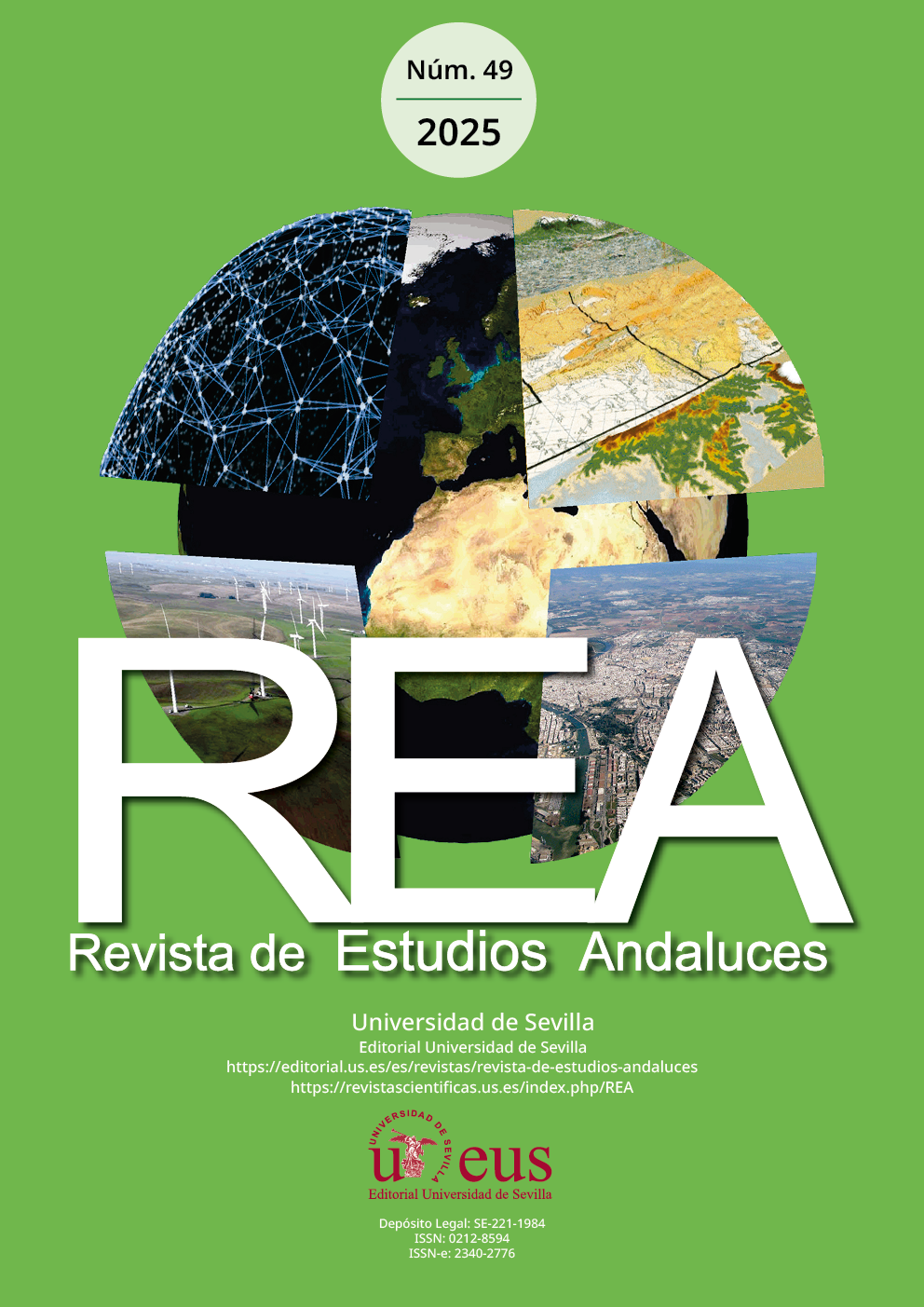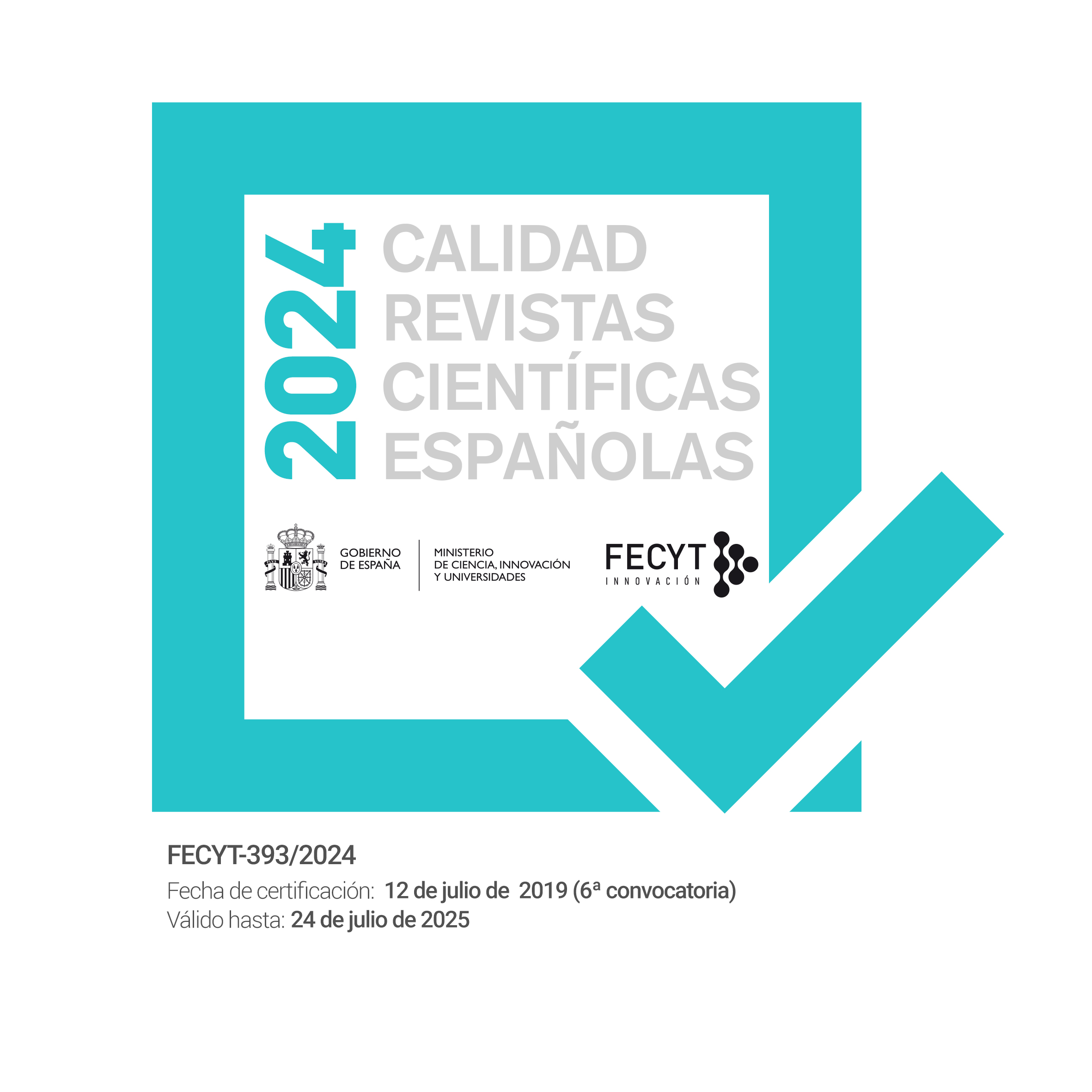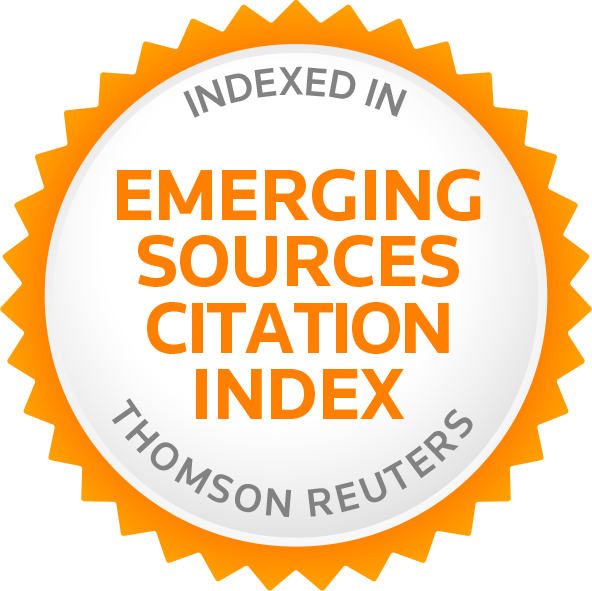Migrantes cualificados en Andalucía: segregación ocupacional y sobrecualificación (2005-2023)
DOI:
https://doi.org/10.12795/rea.2025.i49.10Palabras clave:
Migrantes altamente cualificados, Andalucía, Segregación ocupacionalResumen
Este artículo analiza la segregación ocupacional de los migrantes altamente cualificados que trabajan en Andalucía, comparándola con la de sus homólogos nativos y la de migrantes con otros niveles formativos. Asimismo, se aplican modelos de probabilidad ordenados para conocer qué variables influyen más sobre la posición laboral de este grupo, destacando el impacto de factores como la formación, el idioma y la estabilidad contractual.
Utilizando los microdatos de la Encuesta de Población Activa a lo largo del periodo 2005-2023, que recoge diferentes ciclos económicos, los resultados evidencian que la inversión en formación mejora la posición laboral de los migrantes. A pesar de ello, aproximadamente un 30% de los migrantes con estudios superiores de Andalucía sufren sobrecualificación, demostrando que el mercado laboral andaluz no está aprovechando plenamente el potencial de este colectivo.
Financiación
Este estudio se ha realizado en el marco del proyecto de investigación PID2021-1287630B-100 financiado por MCIN/AEI/10.13039/501100011033/ y FEDER, UE.
Descargas
Citas
Aalto, A.M., Heponiemi, T., Keskimäki, I., Kuusio, H., Hietapakka, L., Lämsä, R., Sinervo, T., & Elovainio, M. (2014). Employment, psychosocial work environment and well-being among migrant and native physicians in Finnish health care. European Journal of Public Health, 24(3), 445-451. https://doi.org/10.1093/eurpub/cku021
Alonso-Villar, O., & del Río, C. (2010). Local versus overall segregation measures. Mathematical Social Sciences, 60(1), 30-38. https://doi.org/10.1016/j.mathsocsci.2010.03.002
Alonso-Villar, O., & del Río, C. (2017). The occupational segregation of African American women in the United States: its evolution from 1940 to 2010. Feminist Economics, 23(1), 108-134.
Anderson, B., & Blinder, S. (2015). Who counts as a migrant? Definitions and their consequences. Migration Observatory Briefing, COMPAS, University of Oxford.
Becker, G.S. (1964). Human capital: a theoretical and empirical analysis with special reference to education. The University of Chicago Press.
Beckhusen, J., Florax, R.J.G.M., Poot, J., & Waldorf, B.S. (2013). Attracting global talent and then what? Overeducated immigrants in the United States. Journal of Regional Science, 53(5), 834-854. https://doi.org/10.1111/jors.12030
Bleakley, H., & Chin, A. (2004). Language skills and earnings: evidence from childhood immigrants. The Review of Economics and Statistics, 86(2), 481-496. https://www.jstor.org/stable/3211642?typeAccessWorkflow=login
Borjas, G.J., & Chiswick, B.R. (2019). Educational mismatch: Are high-skilled immigrants really working in high-skilled jobs, and what price do they pay if they are not? En B. Elsner (Ed.), Foundations of Migration Economics (pp. 385-424). Oxford University Press. https://doi.org/10.1093/oso/9780198788072.003.0016
Boucher, A.K. (2019). How ‘skill’ definition affects the diversity of skilled immigration policies. Journal of Ethnic and Migration Studies. https://doi.org/10.1080/1369183X.2018.1561063
Bretones, F.D., Jain, A., Leka, S., & García-López, P.A. (2020). Psychosocial working conditions and well-being of migrant workers in Spain. International Journal of Environmental Research and Public Health, 17(7). https://doi.org/10.3390/ijerph17072547
Bretones, F.D., & Santos, A. (2020). Health, safety and well-being of migrant workers: new hazards, new workers. Springer. https://doi.org/10.1007/978-3-030-52632-0_1
Buttner, E.H., & Lowe, K.B. (2017). The relationship between perceived pay equity, productivity, and organizational commitment for US professionals of color. Equality, Diversity and Inclusion: An Internacional Journal, 36(1), 73-89. https://doi.org/10.1108/EDI-02-2016-0016
Bygnes, S., & Erdal, M.B. (2017). Liquid migration, grounded lives: considerations about future mobility and settlement among Polish and Spanish migrants in Norway. Journal of Ethnic and Migration Studies, 43(1), 102-118. https://doi.org/10.1080/1369183X.2016.1211004
Cerdin, J.L., Diné, M.A., & Brewster, C. (2014). Qualified immigrants’ success: exploring the motivation to migrate and to integrate. Journal of International Business Studies, 45(2), 151-168. https://doi.org/10.1057/jibs.2013.45
Cetrángolo, O., Curcio, J., & Calligaro, F. (2017). Evolución reciente del sector educativo en la región de América Latina y el Caribe: los casos de Chile, Colombia y México. CEPAL-Serie Macroeconomía del Desarrollo, no191. Naciones Unidas. https://ideas.repec.org/p/ecr/col037/42401.html
Cim, M., Kind, M., & Kleibrink, J. (2020). Occupational mismatch of immigrants in Europe: the role of education and cognitive skills. Education Economics, 28(1), 96-112. https://doi.org/10.1080/09645292.2019.1677558
Crowley-Henry, M., & Al Ariss, A. (2018). Talent management of skilled migrants: propositions and an agenda for future research. International Journal of Human Resource Management, 29(13), 2054-2079. https://doi.org/10.1080/09585192.2016.1262889
Crowley-Henry, M., O’ Connor, E., & Al Ariss, A. (2018). Portrayal of skilled migrants’ careers in business and management studies: a review of the literature and future research agenda. European Management Review, 15(3), 375-394. https://doi.org/10.1111/emre.12072
Dietz, J., Joshi, C., Esses, V.M., Hamilton, L.K., & Gabarrot, F. (2015). The skill paradox: explaining and reducing employment discrimination against skilled immigrants. The International Journal of Human Resource Management, 26(10), 1318-1334. https://doi.org/10.1080/09585192.2014.990398
Farashah, A., Blomquist, T., Al Ariss, A., & Guo, G.C. (2023). Perceived employability of skilled migrants: a systematic review and future research agenda. The International Journal of Human Resource Management, 34(3), 478-528. https://doi.org/10.1080/09585192.2022.2099226
Ferreyra, M.M., Avitabile, C., Botero Álvarez, J., Haimovich Paz, F., & Urzúa, S. (2017). Momento decisivo: la educación superior en América Latina y el Caribe. Resumen. Banco Mundial. https://doi.org/10.1596/978-1-4648-1014-5
Galarneau, D., & Morissette, R. (2008). Immigrants’ education and required job skills. Perspectives on Labour and Income, 21(1), 5-18. https://www.researchgate.net/publication/255590886_Immigrants’_Education_and_Required_Job_Skills
Gandini, L., & Lozano-Ascencio, F. (2016). The effects of the crisis on occupational segregation of skilled migrants from Latin America and the Caribbean in the United States, 2006–2012. Population, Space and Place, 22(5), 441-456. https://doi.org/10.1002/PSP.1909
Garcy, A.M. (2015). Educational mismatch and mortality among native-born workers in Sweden. A 19-year longitudinal study of 2.5 million over-educated, matched and under-educated individuals, 1990-2008. Sociology of Health and Illness, 37(8), 1314-1336. https://doi.org/10.1111/1467-9566.12312
Gradín, C., del Río, C., & Alonso-Villar, O. (2013). Occupational segregation by race and ethnicity in the United States: differences across states. Regional Studies, 49(10), 1621-1638. https://doi.org/10.1080/00343404.2013.864384
Hawthorne, L. (2010). How valuable is «two-step migration»? Labor market outcomes for international student migrants to Australia. Asian and Pacific Migration Journal, 19(1), 5-36. https://doi.org/10.1177/011719681001900102
Heckman, J. (1979). «Sample selection bias as a specification error». Econometrica, 47(1), 153-61. https://doi.org/10.2307/1912352/JSTOR 1912352
Irastorza, N., & Bevelander, P. (2021). Skilled migrants in the Swedish labour market: an analysis of employment, income and occupational status. Sustainability, 13(6), 3428. https://doi.org/10.3390/SU13063428
Jendrissek, D. (2016). Building a future in times of crisis. Young, highly qualified migrants in the UK. Journal of Contemporary European Studies, 24(3), 323-340. https://doi.org/10.1080/14782804.2015.1117965
Labrianidis, L., & Vogiatzis, N. (2013). Highly skilled migration: what differentiates the «brains» who are drained from those who return in the case of Greece? Population, Space and Place, 19(5), 472-486. https://doi.org/10.1002/psp.1726
Mahmud, S., Alam, Q., & Härtel, C. (2014). Mismatches in skills and attributes of immigrants and problems with workplace integration: a study of IT and engineering professionals in Australia. Human Resource Management Journal, 24(3), 339-354. https://doi.org/10.1111/1748-8583.12026
Matos, A., & Liebig, T. (2014). The qualifications of immigrants and their value in the labour market. En OECD/European Union (Ed.), Matching Economic Migration with Labour Market Needs (pp. 187-228). OECD Publishing. https://doi.org/10.1787/9789264216501-9-EN
Mazza, A., & Punzo, A. (2014). On the upward bias of the dissimilarity index and its corrections. Sociological Methods & Research, 44(1), 80-107. https://doi.org/10.1177/0049124114543242
OECD. (2014). Is migration good for the economy? Migration Policy Debates. OECD Publishing.
OECD. (2017). Getting skills right: skills for jobs indicators (Getting Skills Right). OECD. https://doi.org/10.1787/9789264277878-EN
OECD. (2019). Migration Policy Debates. https://www.oecd.org/migration/migration-policy-debates.htm
Palencia-Esteban, A. (2022). Occupational segregation of female and male immigrants in Europe: Accounting for cross-country differences. International Labour Review, 161(3), 341-373. https://doi.org/10.1111/ILR.12207
Pecoraro, M., & Wanner, P. (2019). Does the recognition of foreign credentials decrease the risk for immigrants of being mismatched in education or skills? IMISCOE Research Series, 161-186. https://doi.org/10.1007/978-3-030-05671-1_7/TABLES/6
Rajendran, D., Farquharson, K., & Hewege, C. (2017). Workplace integration: the lived experiences of highly skilled migrants in Australia. Equality, Diversity and Inclusion, 36(5), 437-456. https://doi.org/10.1108/EDI-11-2016-0094
Ramírez Aragón, R., & Bretones, F.D. (2020). Incertidumbres generadas durante el proceso del Brexit entre los trabajadores españoles altamente cualificados. Revista Española de investigaciones Sociológicas, 172, 3-20. https://doi.org/10.5477/cis/reis.172.3
Rooth, D.O., & Ekberg, J. (2006). Occupational mobility for immigrants in Sweden. International Migration, 44(2), 57-77. https://doi.org/10.1111/j.1468-2435.2006.00364.x
Schilgen, B., Nienhaus, A., Handtke, O., Schulz, H., & Mösko, M. (2017). Health situation of migrant and minority nurses: a systematic review. PLoS ONE, 12(6). https://doi.org/10.1371/journal.pone.0179183
Shirmohammadi, M., Beigi, M., & Stewart, J. (2019). Understanding skilled migrants’ employment in the host country: a multidisciplinary review and a conceptual model. The International Journal of Human Resource Management, 30(1), 96-121. https://doi.org/10.1080/09585192.2018.1511615
Tesfai, R. (2020). Immigrants’ occupational segregation in France: “brown-collar” jobs or a Sub-Saharan African disadvantage? Ethnic and Racial Studies, 43(15), 2724-2745. https://doi.org/10.1080/01419870.2019.1686162
Tesfai, R., & Thomas, K.J.A. (2020). Dimensions of Inequality: Black Immigrants’ Occupational Segregation in the United States. Sociology of Race and Ethnicity, 6(1), 1-21. https://doi.org/10.1177/2332649219844799
Townsend, R., Pascal, J., & Delves, M. (2014). South East Asian migrant experiences in regional Victoria: exploring well-being. Journal of Sociology, 50(4), 601-615. https://doi.org/10.1177/1440783312473187
Turchick Hakak, L., Holzinger, I., & Zikic, J. (2010). Barriers and paths to success: Latin American MBAs’ views of employment in Canada. Journal of Managerial Psychology, 25(2), 159-176. https://doi.org/10.1108/02683941011019366
Van Hear, N., Bakewell, O., & Long, K. (2018). Push-pull plus: reconsidering the drivers of migration. Journal of Ethnic and Migration Studies, 44(6), 927-944. https://doi.org/10.1080/1369183X.2017.1384135
Yap, M., Holmes, M., Hannan, C.-A., & Cukier, W. (2014). Correlates of career satisfaction in Canada-the immigrants’ experience. Journal of International Migration and Integration, 15(1), 49-71. https://doi.org/10.1007/s12134-012-0268-y
Zikic, J., Bonache, J., & Cerdin, J.-L. (2010). Crossing national boundaries: A typology of qualified immigrants’ career orientations. Journal of Organizational Behavior, 31, 667-686. https://doi.org/10.1002/job.705
Publicado
Cómo citar
Número
Sección
Licencia
Derechos de autor 2025 Revista de Estudios Andaluces

Esta obra está bajo una licencia internacional Creative Commons Atribución-NoComercial-CompartirIgual 4.0.
La edición electrónica de la Revista de Estudios Andaluces se ofrece en acceso abierto desde el número 28 publicado en 2011 hasta la actualidad. Las ediciones impresa y electrónica de esta Revista son editadas por la Editorial de la Universidad de Sevilla, siendo necesario citar la procedencia en cualquier reproducción parcial o total.
La Revista de Estudios Andaluces no cobra tasas por el envío de trabajos, ni tampoco cuotas por la publicación de sus artículos. La Revista es gratuita desde el momento de la publicación de cada número y sus contenidos se distribuyen con la licencia “CreativeCommons Atribución-NoComercial-SinDerivar 4.0 Internacional” , que permite al usuario de la Revista de Estudios Andaluces criterios que cumplen con la definición de open access de la Declaración de Budapest en favor del acceso abierto. Puede consultar desde aquí la versión informativa y el texto legal de la licencia. Esta circunstancia ha de hacerse constar expresamente de esta forma cuando sea necesario.







